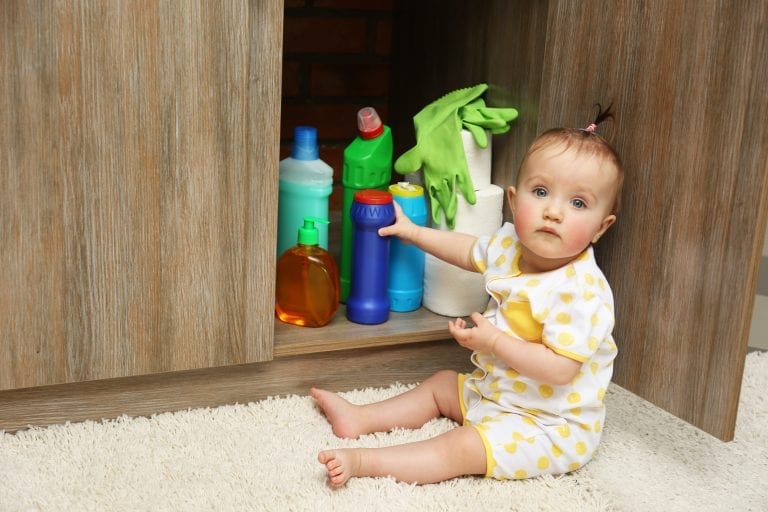Your wee ones are interested in their world, but simple household items can be harmful. Keep ‘em safe and prevent poisonings with these tips.
DANGER: POISON! Adults understand the serious warnings and menacing symbols that tell you something could be dangerous, but to little eyes and curious hands, these are just meaningless squiggles. Anything chemical or items dangerous to babies, toddlers and young children should be locked high and out of sight, recommends the American Association of Poison Control Centers (AAPC). Keep products their original containers (which list ingredients and safety information).
The AAPC reports the following items are particularly dangerous to infants, toddlers and young children:
| Medications | Prescription and over-the-counter medications, ointments, balms, salves, vitamins and supplements, including herbal or ‘natural’ remedies |
| Batteries | Small, shiny lithium “button” batteries—like those in musical cards, older kids’ toys, scales and the like; these can get stuck in a child’s esophagus and result in burns, even death |
| Laundry Detergent | These small, colorful, squishy packets easily catch a child’s attention: In 2016, AAPC received more than 11,000 reports about exposure to these highly concentrated products in children younger than 5; never leave a child younger than 5 alone in a bathroom |
| Personal Care Products | Hair products, makeup, lens solutions, lotions, bubble bath and cleansers |
| Tobacco/E-cigarettes | Tobacco, e-cigs—and while e-cigs may seem like a healthier alternative for adults, these popular substitutes can make youngsters very sick |
| Alcohol and Sanitizers | Even a small amount of alcohol can affect a child’s nervous system and potentially cause trouble breathing, seizures or coma; beyond booze, alcohol is also present in mouthwash, sanitizers and cleaners |
| Lawn/Garden Items and Pesticides | Properly store any fertilizers and pesticides out of reach, ask your local garden center or county extension service for information about safer product options |
| Carbon Monoxide | Carbon monoxide is a colorless, odorless gas that undetected can lead to headaches, flushing, nausea, loss of consciousness and even death. Install battery-powered carbon monoxide detectors on each level of your house |
Be Prepared
Post the numbers for Poison Control and emergency contacts near all phones in the house and garage in your quest to prevent poisonings. Never hesitate to call Poison Control; your information is confidential. If you child is violently ill, has trouble breathing, is unresponsive or passes out, call 911 immediately. DO NOT induce vomiting.
American Association of Poison Control Centers: (800) 222-1222
Be ready to tell them:
- Child’s age and weight
- Label of the poison from container or bottle if available
- Time it happened
- Your address






Comments are closed.